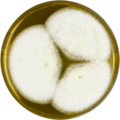| Aspergillus minisclerotigenes | |
|---|---|
| Scientific classification | |
| Kingdom: | Fungi |
| Division: | Ascomycota |
| Class: | Eurotiomycetes |
| Order: | Eurotiales |
| Family: | Aspergillaceae |
| Genus: | Aspergillus |
| Species: | A. minisclerotigenes |
| Binomial name | |
| Aspergillus minisclerotigenes Vaamonde, Frisvad & Samson (2008) [1] | |
Aspergillus minisclerotigenes is a species of fungus in the genus Aspergillus . It is from the Flavi section. [2] The species was first described in 2008. [1] It has been reported to produce aflatoxin B1, aflatoxin B2, aflatoxin G1, aflatoxin G2, aflavarins, aflatrems, aflavinins, aspergillic acid, cyclopiazonic acid, and paspalinine. [2]

